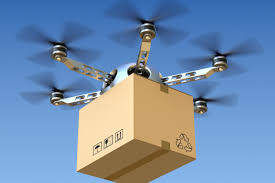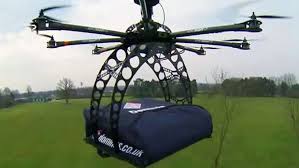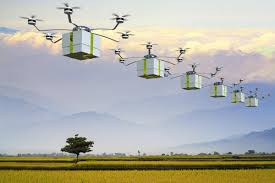January 2016: Unmanned aerial vehicles ( part 3 )
Unmanned aerial vehicles (part 3)
 There is an increasing number unmanned aerial vehicles (RPAS, also often referred to as drones or Remotely Piloted Aircraft Systems (RPAS)) being operated for various reasons. At the same time there are also regularly reports of incidents with RPAS. The wide distribution of RPAS notwithstanding, they are still banned in Belgium. A communication by Ms Jacqueline Galant, Belgian federal Transport Minister, in which she reveals the main elements of a new Royal Decree, has again stirred public debate on the issue. This debate, however, often neglects to take account of existing international and supra-national frameworks that already contain (binding) regulations on a number of important issues. In our RPAS newsletter series we will examine the key questions that arise concerning authorisation, liability, and the use of images, all of this with respect to both current and future law. The focus here will be on professional use. This last issue of the newsletter series zooms in on the use of images made by means of a RPAS and privacy matters matters.
There is an increasing number unmanned aerial vehicles (RPAS, also often referred to as drones or Remotely Piloted Aircraft Systems (RPAS)) being operated for various reasons. At the same time there are also regularly reports of incidents with RPAS. The wide distribution of RPAS notwithstanding, they are still banned in Belgium. A communication by Ms Jacqueline Galant, Belgian federal Transport Minister, in which she reveals the main elements of a new Royal Decree, has again stirred public debate on the issue. This debate, however, often neglects to take account of existing international and supra-national frameworks that already contain (binding) regulations on a number of important issues. In our RPAS newsletter series we will examine the key questions that arise concerning authorisation, liability, and the use of images, all of this with respect to both current and future law. The focus here will be on professional use. This last issue of the newsletter series zooms in on the use of images made by means of a RPAS and privacy matters matters.
Use of images ?
Possible applications of RPAS often cited include surveillance and aerial photography or filming from the air. While proponents view such use as a great opportunity, opponents often refer to possible invasions of privacy. It is very easy to spy on people from a RPAS since they are almost invisible from high altitudes: ‘victims’ of such surveillance would not even know they are being ‘spied on’. Here too, however, there is already an extensive legislative framework: article 8 ECHR and article 22 of the Constitution protect public privacy in general, but the Camera Act is also applicable to the use of surveillance cameras (A) and the Privacy Act to the processing of personal data (B). Provided that the use of RPAS meets the conditions for applying these specific laws, they obviously also apply to RPAS. In addition, these laws could mean a major limitation to the possible use of RPAS.
 Camera Act
Camera Act
While surveillance operations at for example industrial sites are repeatedly referred to as a possible use of RPAS, such use is greatly restricted by the Camera Act. RPAS constitute mobile surveillance cameras, and thus fall under the stricter rules of the Camera Act. Article 7/1 of the Camera Act stipulates among other things that the use of RPAS for surveillance is possible only by the police, and then only in specific circumstances. Restrictions apply to both the nature of the task (in the context of controlling large crowds or for the purpose of automatic license plate recognition), the duration of use (not continuous) and the location of use (locations that are not private or on private locations open to the public). Moreover, there are various formalities to be followed in the use of mobile cameras by the police, as well as in the use of the acquired images (article 2/7 Camera Act). While at the moment the lack of a Royal Decree is also cited as an obstacle standing in the way of carrying out surveillance missions using RPAS, it should be clear that even after the Royal Decree, such use by private companies would still be forbidden on locations that are not private or on private locations open to the public. On the other hand, RPAS could be usefully deployed in the future on individual business sites. Insofar as surveillance is limited to areas that are not accessible to the public, but that can only be accessed by personnel, the use of surveillance cameras is indeed allowed here.
Privacy Act
RPAS may also be usefully deployed for processing personal data. Unless this is done in the context of purely private use (art. 3.2 Privacy Act), the various conditions imposed by the Privacy Act must be met when processing personal data, and account must be taken of the formalities required for such processing.
“Unless this is done in the context of purely private use,
the various conditions imposed by the Privacy Act must
be met when processing personal data, and account must
be taken of the formalities required for such processing.”
Moreover, the conditions imposed by the Privacy Act could also raise practical problems for use of RPAS. Thus, processing is only possible with permission, in the case of necessity or insofar as proportionality is respected (art. 5 Privacy Act). The first question is how consent can be obtained from those involved when processing the data by means of RPAS. The Privacy Commission explicitly states, in the context of the question whether the processing is within the reasonable expectations of the person whose data is being processed, that it is not because it take places in a public space that one might reasonably expect the processing of personal data. For the same reason, finding oneself in a location where RPAS are filming can certainly not be considered implicit consent to the processing of personal data.
 Furthermore, article 4 (1) requires that the processing is done fairly and lawfully. In this, the processing is fair if it is not carried out fraudulently or secretly, and is not beyond the reasonable expectations of the people involved. The problem here is that RPAS sometimes operate at high altitude (90 meters), making it difficult or even impossible to see them from the ground, which might violate this article.
Furthermore, article 4 (1) requires that the processing is done fairly and lawfully. In this, the processing is fair if it is not carried out fraudulently or secretly, and is not beyond the reasonable expectations of the people involved. The problem here is that RPAS sometimes operate at high altitude (90 meters), making it difficult or even impossible to see them from the ground, which might violate this article.
Finally, unless the processing is done for scientific or journalistic purposes, notification must be given to the person concerned about the data processor and the purpose of the processing. Here again, the question is how this can be done in practice, when the personal data is processed by means of RPAS.
With regard to the requirement, the Privacy Committee recommends that the processing not be hidden, that the RPAS be painted in a bright colour. This after all makes the aircraft more visible. Moreover, the use of RPAS for the processing of personal data must be announced in advance. Notice can also be given of the identity of the processor using the latter method. Alternatively, this can be done via a visible identification on the RPAS, or by the use of specific colours that refer to a company.
Although the processing of personal data by RPAS certainly is not excluded, after the Royal Decree that permits the use of RPAS, there will still be a number of practical obstacles that must be overcome for the processing of data to be possible.
Conclusion: unmanned air vehicles: helicopter vision required!
This article makes it clear that helicopter vision is required in the creation of regulations for RPAS as well as in the application of this legislation in the case of disputes, since quite a number of relevant regulations are spread across various international, supranational and national standards.
For the sector actors
When contracting, the contracting party for the air carrier must take into account the very limited compensation in the case of damage to transported goods, cargo or payload, and a value-declaration is therefore appropriate. For possible damage on the ground, it is recommended that the contracting party negotiate the inclusion of a clause providing for a higher or full compensation. Moreover, for all parties concerned, it is important not to be blinded by the innovative potential of RPAS but, prior to R&D efforts, to also view the intended use in the broader legal framework in order to ensure that it does not contravene other legal provisions.
For the legislator
When making regulations and balancing the interests, the conventions and European regulations with an impact on safety, the protection of privacy and limitations to the scope of doing business must be taken into account. Therefore, as stated above in determining safety standards in the Royal Decree, account must be taken for example of the limited liability in the case of damage on the ground based on the 1952 Rome Convention. This should result in either very strict safety standards or higher liability in the case of damage on the ground. For example, unlimited and strict liability applies in the UK in the case of damage on the ground.
An additional question is whether the legislator also must not do something to limit somewhat the helicopter vision required for the sector actors. Obviously, everyone is presumed to know the law, but taking into account the fact that so many rules are applied outside their natural scope in the case of RPAS, there is still the potential for significant ignorance of the law. One possible method to limit this risk of legal ignorance is to follow the method currently being used by the Commission in revising the Maritime Act in its review project. There it was decided to also ‘copy’ directly applicable international regimes in the legal code. While from a legal point of view this adds no extra value, it can be an important measure to combat the ignorance of the law that now threatens in this matter.
 Lessons for the future?
Lessons for the future?
Finally, a number of lessons to be learned for the future from the legislation troubles in creating a framework for RPAS. After all, self-propelled vehicles (cars as well as trucks), and even self-propelled container ships will also become possibilities in the near future. This sometimes requires unravelling a significant legal tangle, for example in the case of unmanned transport, consideration must also be taken of the extensive, and often mandatory, legal provisions regulating transport. These rules will sometimes require change, or at least need to be clarified in order to be applied to unmanned vehicles and vessels. Moreover, while it is possible to reserve a ‘zone’ for RPAS, this is not possible for self-driving vehicles and self-sailing container ships, which necessarily must interact with manned traffic. This makes the safety aspects even more important. In addition, the legislator is faced with a legal chicken-or-egg problem: do you write legislation once the technology is available, or do you first create regulations before the technology is available?
Although the second option runs the risk of creating self-driving vehicle legislation for technology that ultimately never comes to fruition, there are a number of important advantages that make it the preferable option. The unmanned aviation sector argues that the lack of a legal framework is causing Belgian companies to lose their frontrunner status. However, leadership in legal innovation could precisely make Belgium a pioneering country for innovative businesses. In addition, the premature creation of legislation avoids great pressure being placed by a sector lobby, as was the case for the unmanned aviation sector. This not only makes it possible to make faster progress towards regulation, but also enables broader international and European consultation. Technological leadership can only be optimally valorised if there is easy access to foreign markets. The existence of uniform rules plays a key role here. This view certainly seems to be shared for self-driving vehicles, since work is already being made at different levels on regulations in this area.
“The unmanned aviation sector argues that the lack of a
legal framework is causing Belgian companies to lose
their frontrunner status. However, leadership in legal
innovation could precisely make Belgium a pioneering
country for innovative businesses.”
If the legislature continues to merely react to the creation of innovative technology, the tension between the law and innovation will remain, as will the continual tug of war that we have witnessed in recent years. However, if the legislature acts proactively, the law could precisely be a catalyst for developing new technology.
For further information and comment, please contact Arthur Flieger (flieger@fliegerlaw.com, +32 3 238 77 66)
© 2016 A. Flieger – This publication is defined to provide accurate and authoritative information in regard to the subject matter covered. It is transmitted with the understanding that the publisher is not engaged in rendering legal, or any other professional services. If legal advice or other expert assistance is required, professional services should be sought. You can always contact A. Flieger at flieger@fliegerlaw.com.






